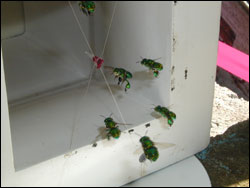Flying tip of bees: leave your legs dangling!

Bee flying towards aromatic feeder (Credit: Sagiri Horisawa)
When orchid bees extend their hind-legs they pitch forward to achieve maximal speed, and the legs produce lift forces to either side that help prevent the bee from rolling. “The hind-legs resemble airplane wings, which probably explains why they also generate lift”, says Dr Stacey Combes from the University of California, Berkeley who will present her research on Tuesday 4th April at the Society for Experimental Biology’s Annual Main Meeting in Canterbury, Kent [session A7].
This research is interesting as it could be applied to design miniature flying machines to be used for search and rescue missions. “It may be helpful to be able to reduce the number of control components needed by using one structure (like the orchid bee legs) to control both pitch and roll”, speculates Dr Combes.
The researchers perform their experiments by encouraging the bees to fly in an outdoor wind tunnel using an incentive of aromatic oils. The bees can reach a maximum speed of 7.25 m/s, but at these speeds they lose rotational stability: “They roll all the way to the side or often upside down, and crash to the ground”, observes Combes. This means that what limits the bee’s speed is not muscle power or the amplitude of its wing beat, but the pitch of the body balanced with the resulting rotational instability. “Having the legs extended generates stabilizing lift forces and helps reduce the moment of inertia and the slow rolling, similar to when a spinning figure-skater extends their arms”, explains Combes.
Media Contact
More Information:
http://www.sebiology.org.uk/Meetings/pageview.asp?S=2&mid=88All latest news from the category: Life Sciences and Chemistry
Articles and reports from the Life Sciences and chemistry area deal with applied and basic research into modern biology, chemistry and human medicine.
Valuable information can be found on a range of life sciences fields including bacteriology, biochemistry, bionics, bioinformatics, biophysics, biotechnology, genetics, geobotany, human biology, marine biology, microbiology, molecular biology, cellular biology, zoology, bioinorganic chemistry, microchemistry and environmental chemistry.
Newest articles

Stretchable quantum dot display
Intrinsically stretchable quantum dot-based light-emitting diodes achieved record-breaking performance. A team of South Korean scientists led by Professor KIM Dae-Hyeong of the Center for Nanoparticle Research within the Institute for…

Internet can achieve quantum speed with light saved as sound
Researchers at the University of Copenhagen’s Niels Bohr Institute have developed a new way to create quantum memory: A small drum can store data sent with light in its sonic…

A chip unique in the world
A team from UPV and iPRONICS has manufactured the first universal, programmable and multifunctional photonic chip on the market. A team from the Photonics Research Laboratory (PRL)-iTEAM of the Universitat…





















